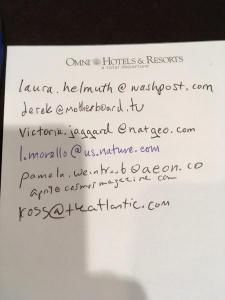By Sheila Yong
Pitch slam for ScienceWriters2016 began in a bustling room of science writers of all ages with various levels of experience, many of whom came prepared with story ideas.
A panel of seven editors from the Atlantic, the Washington Post, National Geographic, Motherboard, Nature, COSMOS, and Aeon were eager to listen to these pitches. “We are here because we want to hear your pitches. It’s what we do, and you make our job easier,” said Laura Helmuth from the Washington Post.
As the editors introduced themselves and their respective publications, it became clear that each of these publications is unique and caters to different audiences. For instance, while Motherboard caters to savvy readers seeking experiential and subversive stories, COSMOS’s readers range from high school students to professionals with Ph.D. degrees. Therefore, it is important for writers to research the publication they want to pitch their stories to so that they can structure their pitch appropriately.The editors also welcomed pitches that involve photos, videos, and other creative or interactive media. “We have a video team at Aeon that curates and also makes videos, and they are constantly looking,” offered Pamela Weintraub from Aeon. Victoria Jaggard from National Geographic concurred. “We have some amazing talented professionals on staff who are going to be super excited to work with you, and it will be huge value added to any pitch that you bring us.”
While these publications may differ from one another, they all strive towards a common goal — to publish something new. That said, it does not need to be current news. In fact, Aeon does not cover news. In essence, a good pitch should provide a fresh take on a story and, if it is about a previously covered story, new ideas that have emerged since previous publications.
Another important point is to find a good hook for the story. The editors offered several suggestions on how to achieve this based on the nature of their respective publications. “Health stories that start with ’this happened to me’ tend to do really well,” Helmuth said. April Reese from COSMOS suggested turning a story into a profile piece as a good approach if it has a strong character. Ross Andersen from the Atlantic pointed out that stories with a weird or unusual historical perspective that links to them to the present day tend to be very popular as well.
Despite the time constraint, the attendees were able to hear an impressive 14 one-minute pitches encompassing topics on the outer space, sports, animal behavior, conservation, genetics, neurobiology, neuroscience, infectious diseases, and medicine. It was a true test of how brief one could be, while still able to present story ideas effectively. “Shorter is always better than longer, really” stressed Lauren Morello from Nature.
The editors’ comments were helpful not only to those who pitched, but also to others who are still formulating that great idea. Perhaps I will give it a shot at the next meeting.




